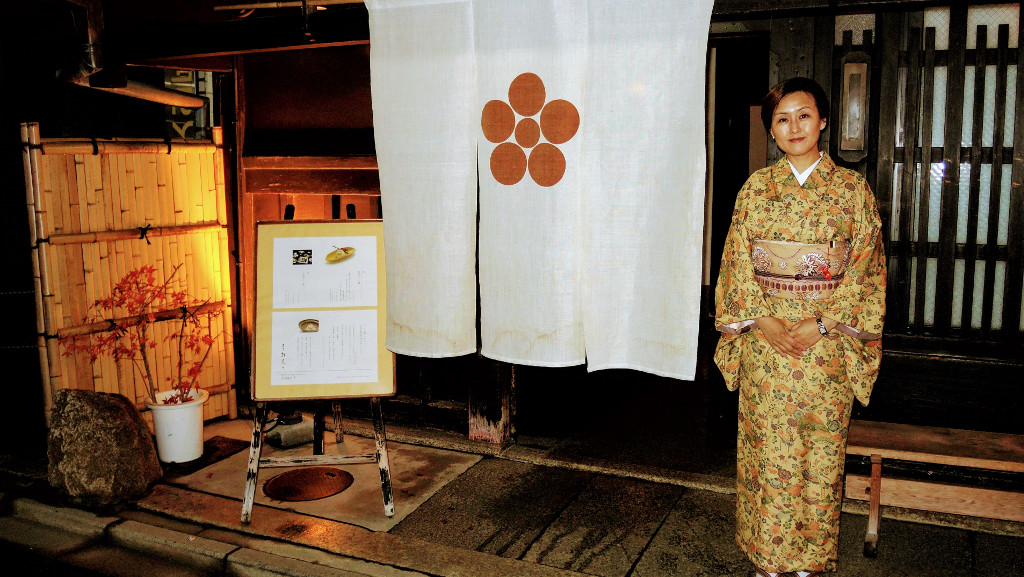You know soybeans.
You've even cultivated a taste for tofu.
Well, now there's another high nutritional variant for you to discover: yuba. Aka tofu skin.
I recently tried yuba for the first time at the charming Seike Yuba restaurant in Kyoto which serves exquisite kaiseki courses showcasing this delicate product.
Seike Yuba (tofu skin) Restaurant, Kyoto
by Rob Dyer
The history of yuba
Yuba is said to have been introduced by Zen Buddhist monks from China over 2,000 years ago. In the Kamakura period (1185 - 1333), yuba was used in shojin ryori (Buddhist vegan cuisine) in Zen temples, and because of its rich taste and high nutritional value.
In Asia yuba is a feature of the daily diet in many regions. With the abundant water resources in Japan, and the demand for ingredients that reveal a delicate artistry, yuba has become a specialized ingredient in Japanese cuisine.
Today, Japanese yuba, known as toupi (Chinese for 'bean skin'), is a valued soybean health food, and has become highly prized in Kyoto, especially by monks.
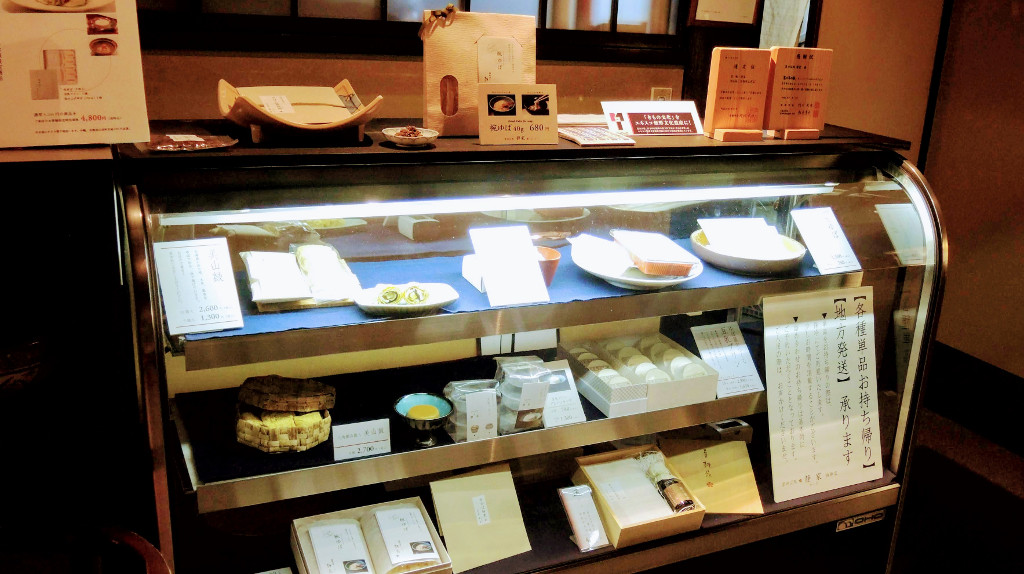
A selection of yuba-based goods are available to buy at the restaurant
Making a culinary artform
The process of making yuba utilizes something called the Ramsden Phenomenon whereby the proteins and fats in heated soy milk are solidified by changes in temperature.
It is something of a culinary artform to expertly time the approximate 8-minute cycles of lifting the completed yuba film from the surface of the soy milk. Consequently, yuba is an extremely delicate product.
VIDEO: Making and Experiencing Yuba
Kyoto's Senryogatsuji neighbourhood
Established in an authentic machiya townhouse in Kyoto, Seike Yuba is an elegant yuba restaurant offering the best of soy foods.
It's located in the Senryogatsuji neighbourhood of Nishijin.

Seike Yuba's Nishijin restaurant is a machiya townhouse
Historically, it was a business district where the streets were lined with textile merchants. Their sales reached 1,000 ryo (the old monetary measurement) of business per day, and thus garnered the name "Thousand-ryo Crossing" (Sen-ryo-gatsuji).
Seike Yuba's machiya townhouse retains its historical charm. Something the citizens of the city are agreed upon, as it was awarded Irodori 24th status, recognising it as one of 'The buildings and gardens which make Kyoto attractive'.
If you're interested in exploring some of Kyoto's lesser-known but historically significant sites then this post about 3 hidden Kyoto walks might be of interest.
An elegant yuba restaurant in Kyoto
Seike Yuba's proprietress Tomoko Nakata is understandably proud of her family's business.
In addition to this branch in Nishijin, there is a second restaurant in Kyoto's Nijojo district, as well as a main store, third restaurant and Seike's yuba production facility in Miyama, in north Kyoto Prefecture.
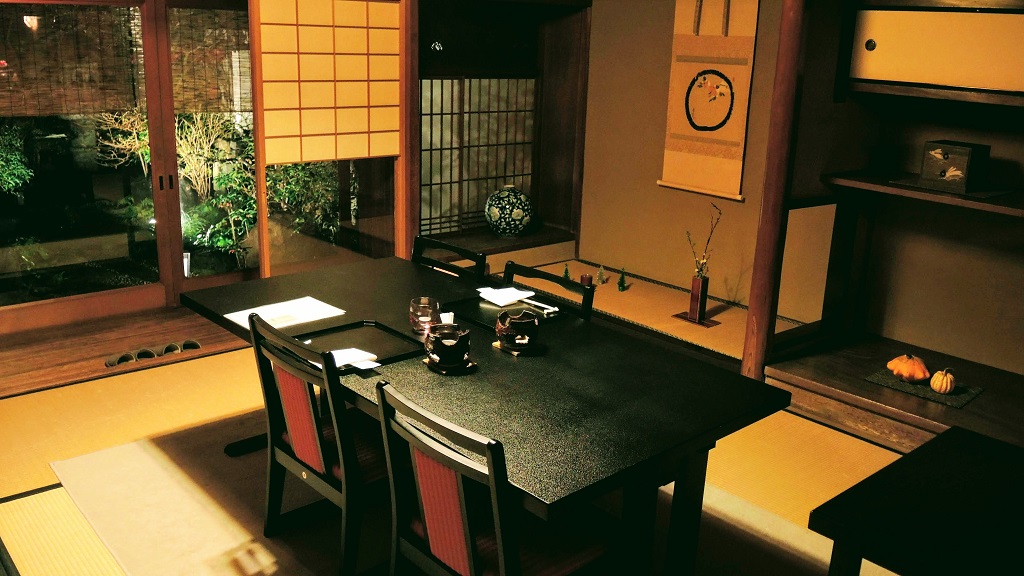
Elegant traditional-styled rooms, old-world charm
The Nishijin branch offers a chance to enjoy yuba cuisine in a relaxed setting. They have 38 seats available at tables in authentically-decorated Japanese rooms.
Here you can enjoy a wide variety of dishes featuring yuba as a key ingredient. If you contact the restaurant ahead of time, they can serve those following specific diets including vegetarian, vegan, and special Buddhist diets.

Authentically-decorated Japanese interiors
At the rear of the restaurant is a traditional Kyoto-style garden, which is lit at nighttime, lending another dimension to the feeling that you could be dining hundreds of years ago.
It's possible to take a table overlooking the Japanese garden, making it the perfect backdrop either to an afternoon lunch or an evening's dining.

The traditional Japanese garden
A variety of yuba dishes
Seike offers Yuba zukushi, a Kyoto-style kaiseki course. Yuba zukushi uses yuba as the main element in all the dishes.
They have used their culinary skills to create dishes in which seasonal vegetables enhance the fresh taste of uncooked yuba. They also feature Western-inspired dishes, and have developed their menu so that you can try all kinds of yuba courses.
Three-course menus are available for both lunch and dinner.
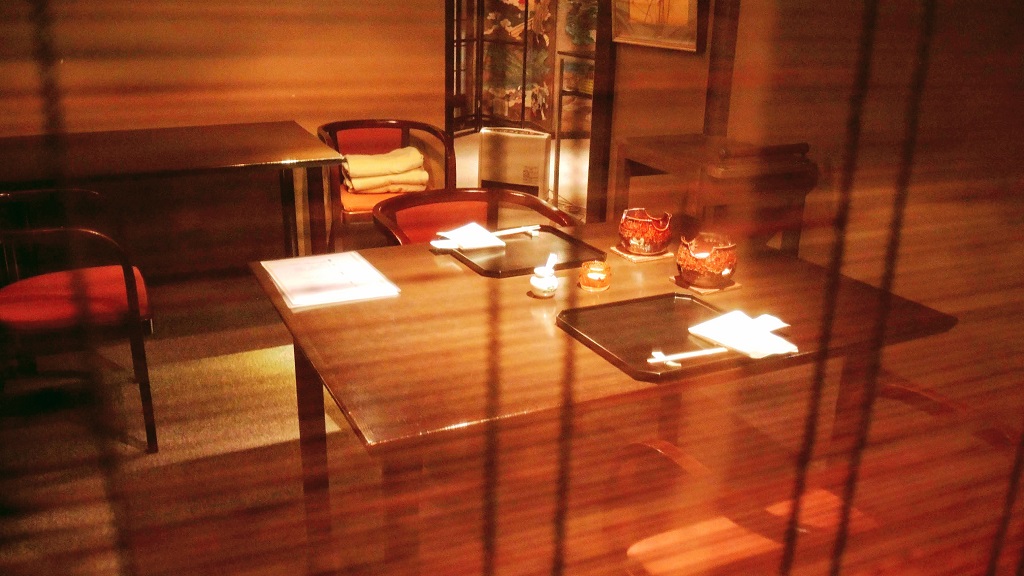
Seike Yuba's interior is peaceful and calming
Sake, shochu, wine, beer, hojicha
The drink menu includes a selection of wines, shochu, beers and soft drinks. The hojicha (roasted green tea) is free.
A range of sake's is also available. These start at 870yen for a 120ml of the cold Nouvel JyumaiGinjyoake. Finishing at the top end, with a 300ml bottle of the fruity flavoured Jyurakudai jyunmai Daiginjo at 3,250yen.
If you love sake but don't know what to select or want to know more, Voyagin offer a Kyoto Sake Insider Experience that can help you learn how to select your favorite sake using bottle labels and restaurant menus.
We wanted something more refreshing, so opted for a couple of glasses of Suntory Premium Malts (one of my favourite mainstream Japanese beers).
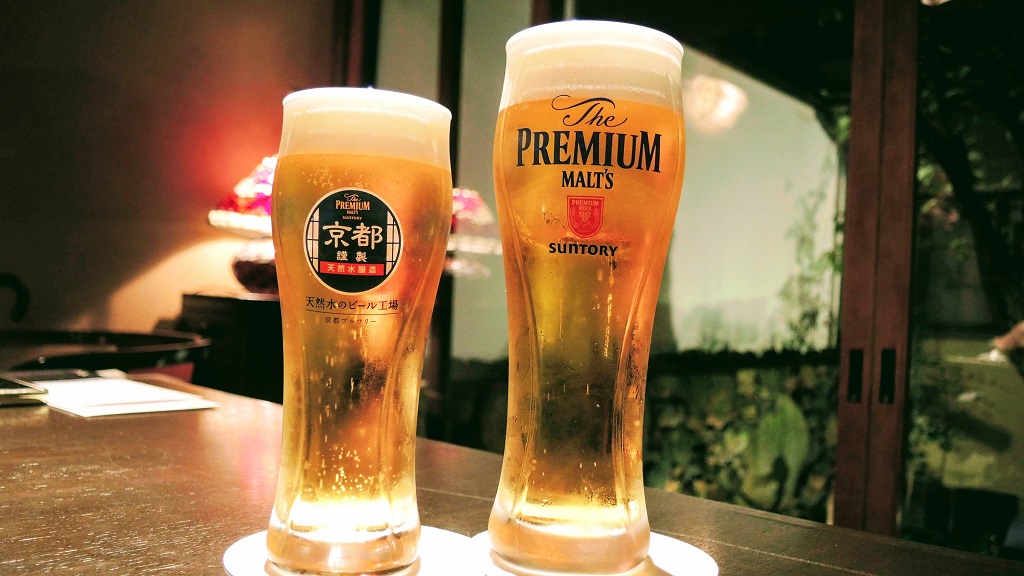
If you simply fancy a beer with your meal, that's no problem
Yuba Zukushi: Our course-by-course guide
When we ate here the yuba zukushi consisted of nine courses, but one was unavailable on the day we dined, the full experience runs to ten courses.
The restaurant selects superior quality soybeans from different regions around Japan, blends them in a specific proportion (aka a 'secret recipe'!), to produce their own uniquely tasting yuba.
First up, as something of a palate 'acclimatiser' was a glass of soy milk. A simple introduction to the source of yuba.

Soy milk soup
Kumiage Yuba: A pyramid of creamy yuba
Second course was kumiage yuba. A modest pyramid of creamy, slightly sweet-tasting yuba. This yuba in its purest form, its goal to awaken diners' tastebuds to the delicate flavour.
Next up was soy milk soup. It's made with seasonal vegetables, meaning its appearance varies from season to season. It was served in a small, lidded pot. It had a subtle yellow cream appearance.
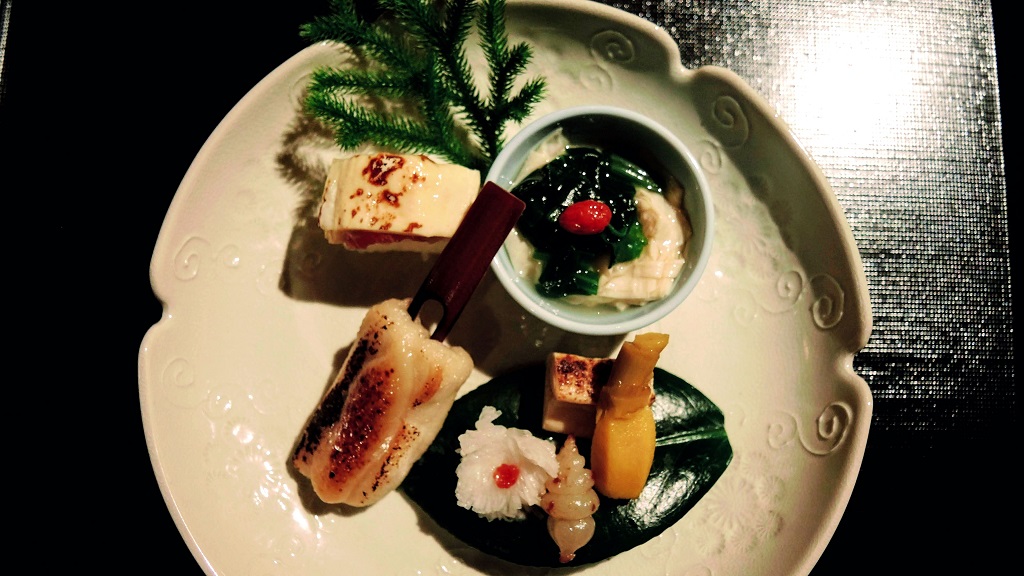
Hassun - an assortment of yuba dishes
Colour was injected into the dish with a splash of something dark green (I'm gonna guess some sort of seaweed reduction). A pink ribbon of tiny fish roe was accompanied by a sprinkling of two or three pine nuts.
The fourth course was something called hassun - an assortment of yuba. Again, driven by a seasonal theme, it consisted of several small yuba dishes with vegetables and one kind of yuba sushi.
The presentation was wonderful, with one dish looking like a white petalled flower with a bright orange centre. In fact, every course was presented on a carefully chosen piece of handmade pottery, something the Japanese do so elegantly.
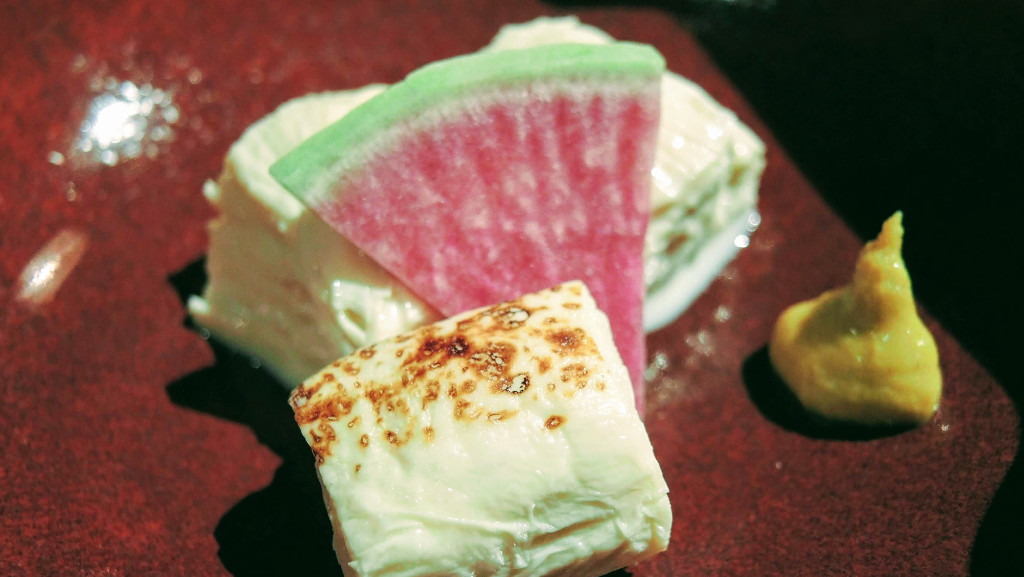
'Sashimi' yuba is a chance to experience the textures of pure yuba
Textures of 'sashimi' yuba
Course five was 'sashimi' yuba. Fresh yuba's texture changes with the way it is lifted from the soy milk. Lifted by hand, it is softer. Lifted by bamboo rods, it is harder. This dish offers up both so you can compare the textures.
Perhaps the visual highlight of the meal was the sixth course: yuba 'steak'. Showcasing the product's versatility, this butter sauteed strips of yuba is baked at your table until it is golden brown.

Yuba 'steak' is cooked at your table
Accompanied by a selection of mushrooms, spring onions and carrots the entire dish is placed over a small candle to finish the cooking in front of you. It is ready to eat when it begins to puff up. Best eaten with soy sauce and sesame miso sauce.
Miyama tsuzumi takiawase would usually follow, but this was the course missing from our kaiseki. Apparently, it consists of lily bulbs, ginko nuts and kikurage mountain mushrooms wrapped in yuba and deep fried.
VIDEO: Cooking Yuba 'Steak'
Yuba shabu with ponzu
If you've eaten in Japan a few times, chances are you've come across the delicious shabu shabu. Paper-thin pieces of beef that you dip into a broth for a few seconds to cook. Well, our seventh dish was yuba shabu.
Although the method was the same, the visual and taste experience was quite different. This is served with warm soy milk and strands of yuba in a small pan. First, you dip the yuba in ponzu (citrus flavoured soy sauce).
Then you leave some of the soup so they can add nigari (a special coagulant) to make tofu. Just add salt or soy sauce to taste.
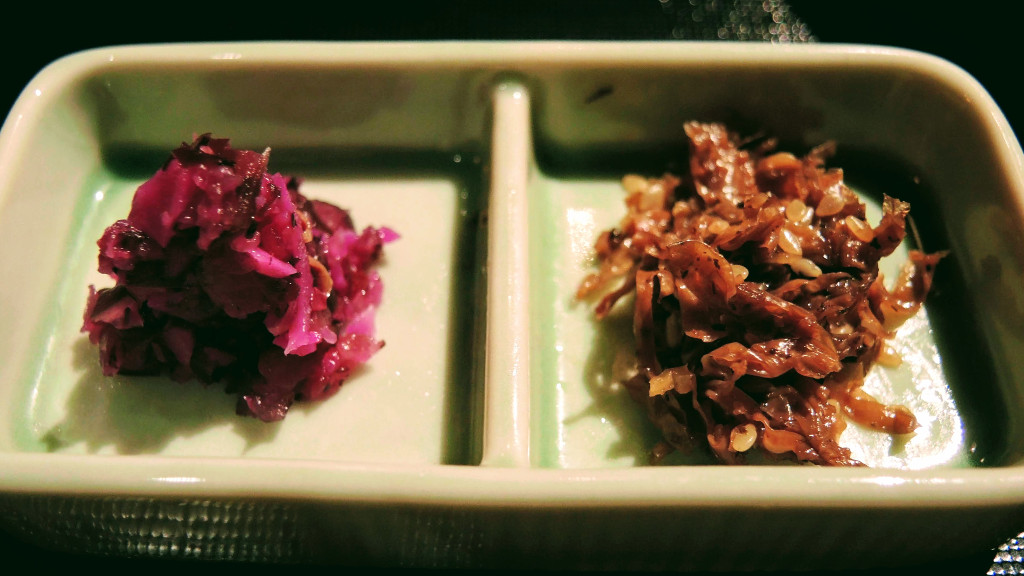
Shibazuke: salted, chopped pickled vegetables
Our eighth, and penultimate dish, was yuba koucha shigure and shibazuke pickles.
Here, the yuba is simmered with tea leaves, ginger and soy sauce so that, like tofu, it takes on the flavour of the accompanying ingredients. A raw egg yolk was served on top of ours but, as with all the dishes at Seike Yuba, a vegan version is available on request in advance.
(There's more about tofu and tofu restaurants in the city in my Kyoto City Guide.)
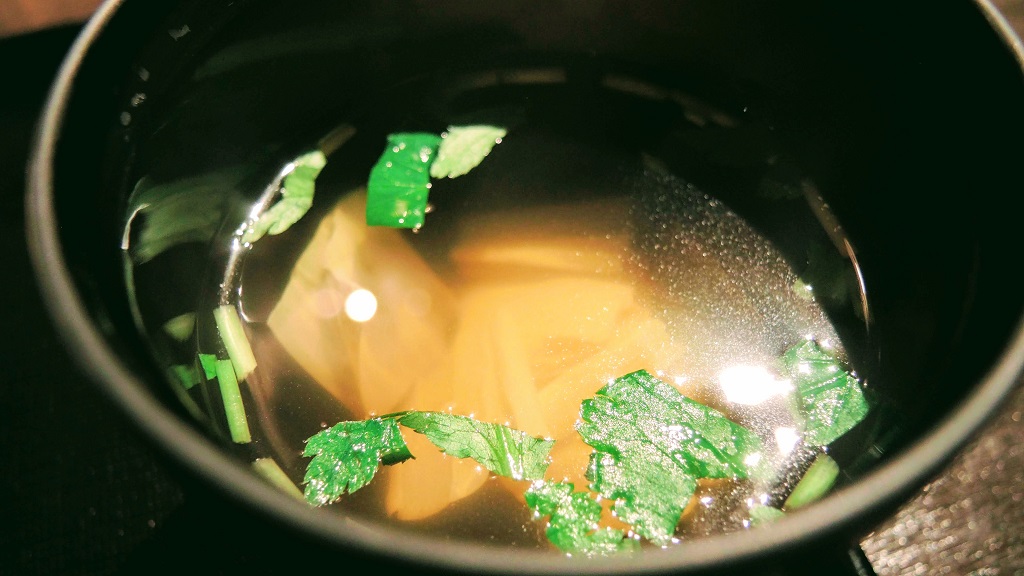
Clear soup acts as a palate cleanser ahead of the final dish
Shibazuke is salted, chopped pickled vegetables with shiso leaves, served with rice and a clear soup. Aside from the yuba steak, this was the most substantial course, with both the white rice and clear soup acting as palate cleansers ahead of the final dish.
A welcome hint of sweetness
That final, ninth, course was a simple soy milk pudding. Texture wise, this was somewhere between a panna cotta and a creme caramel. With a welcome hint of sweetness, this was a perfectly light way to conclude what had been a feast of textures.
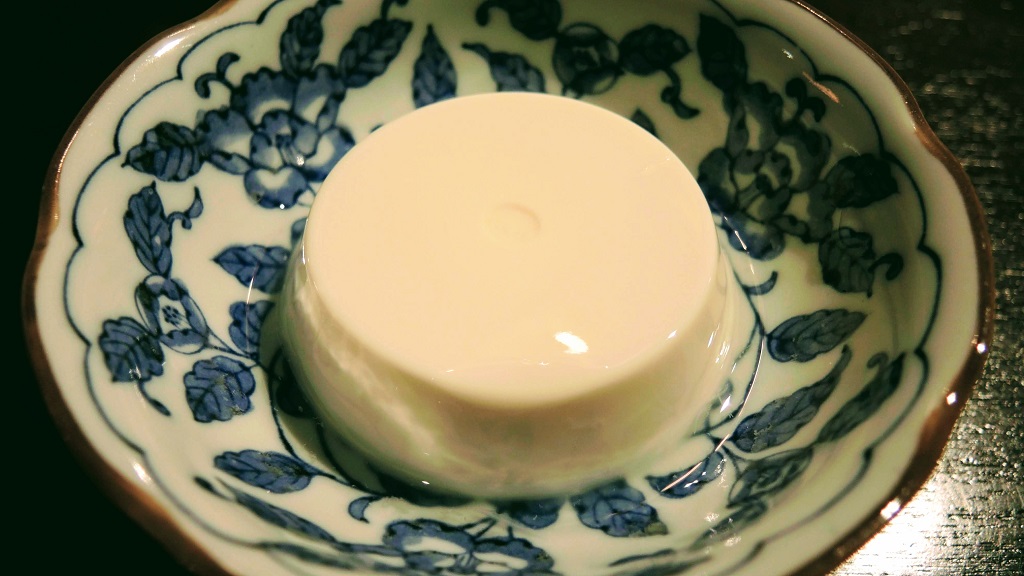
Soy milk pudding: a welcome hint of sweetness
One of the key goals at Seike is to awaken diners' tastebuds with the delicate flavour of the yuba they proudly serve. And they achieve that goal in stunning fashion.
Should you try yuba?
If you like to try something new, are vegetarian or vegan*, or simply want to dine on unique Japanese cuisine then you ought to try yuba at least once.
*Just remember, if you are vegetarian or vegan you'll need to notify the restaurant in advance, so they can prepare your food in accordance with your needs.
Provided you approach eating yuba as an exercise as much in the exploration of textures as tastes, then you will be better attuned to its subtle flavours.
If you've dined much on tofu, and have a taste for it, then yuba is a natural extension of that dining experience. If you want to do that in Kyoto, in a building steeped in tradition and character, then I can easily recommend Seike Yuba.
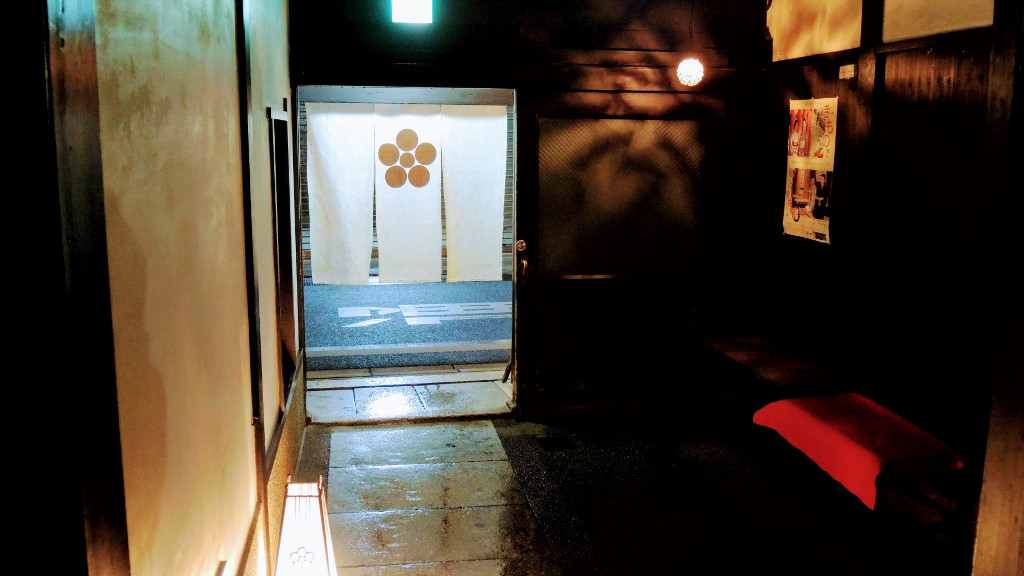
Entrance to Seike Yuba, Nishijin
Opening hours
Daytime: 11:30 - 14:30 (last entrance) Menu starts at 4,180yen
Nighttime: 17:00 - 19:45 (last entrance) Menu starts at 5,940yen
Closed: every Wednesday and the beginning and end of the year
The owners have two restaurants in Kyoto and a store at their production facility in Miyama, a small town in central Kyoto Prefecture (see Resource below for contact details on all of these).
*Just remember, if you are vegetarian or vegan you'll need to notify the restaurant in advance, so they can prepare your food in accordance with your needs.
Getting here
The Nishijin restaurant, where we dined, is about 20 minutes by taxi from Kyoto Station. The nearest bus stop is "Imadegawa-Omiya" - just 1 minute on foot. Or a 15-minute walk from Imadegawa station on the Karasuma Line of the Kyoto subway.
The full address (and of those for the other two branches of Seike) can be found below.
Location Map

About the Author
A writer and publisher from England, Rob has been exploring Japan’s islands since 2000. He specialises in travelling off the beaten track, whether on remote atolls or in the hidden streets of major cities. He’s the founder of TheRealJapan.com.
Resources
Seike Yuba Restaurants and Store
Nishijin restaurant
234 Yakushi-cho
Imadegawa-dori-sagaru,
Omiya-dori
Kamigyo-ku
Kyoto 602-8447
Phone: +88 (0)75-468-8487
http://seike-yuba.com/nishijin/
Nijojo restaurant
233-4 Daimonjicho,
Kuromon,
Oikedori,
Nakagyo-ku Kyoto
TEL : 81-(0)75-813-1517
Email: [email protected]
Miyama Store (and yuba production)
The main store and yuba production of Seike (along with a restaurant) can be found in Miyama here:
36-1 Shimohiraya
Miyama-cho
Nantan-shi
Kyoto 601-0732
Tofu Food Experiences
https://www.byfood.com/tofu-food-experiences
Japan Travel Guidebook
Learn more about my guide How to Travel in Japan Without Speaking Japanese HERE (includes details on Kyoto's foreigner friendly taxi service).
If you enjoyed this article please share this image online:



